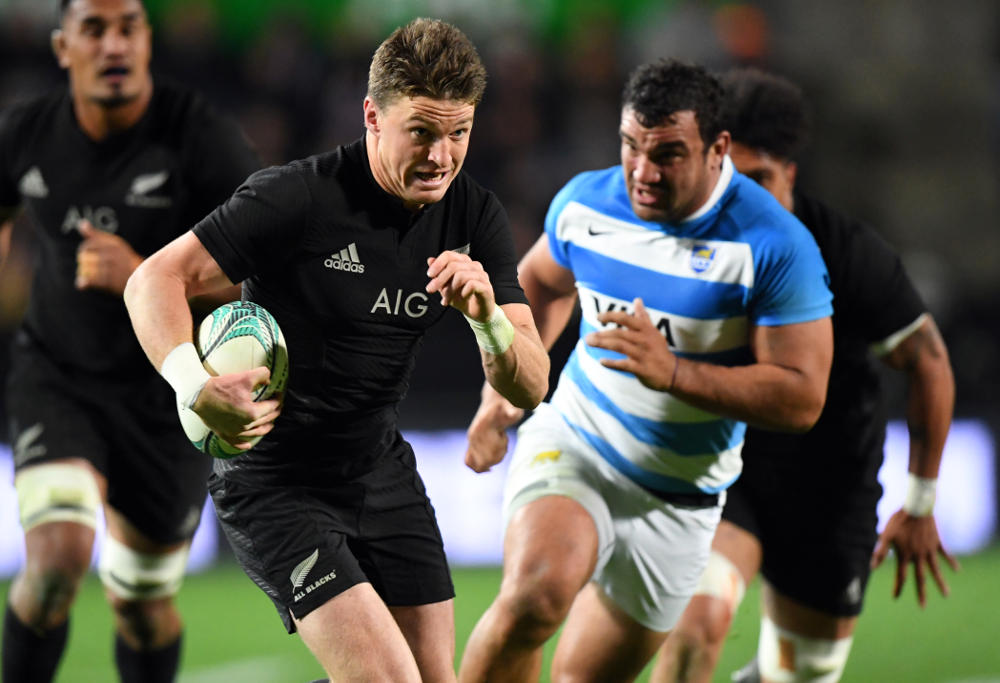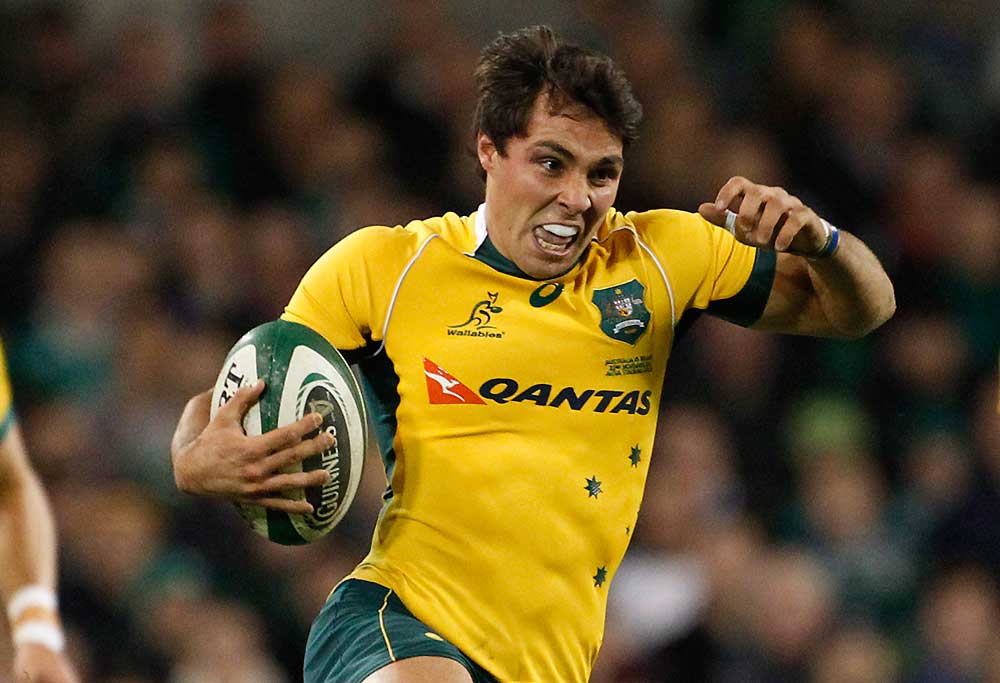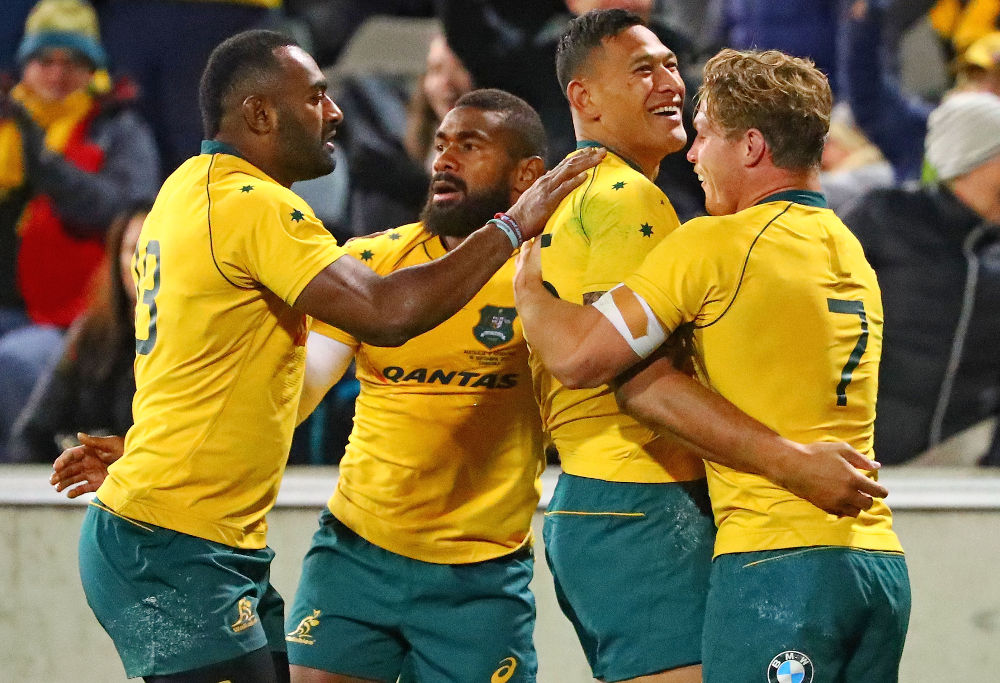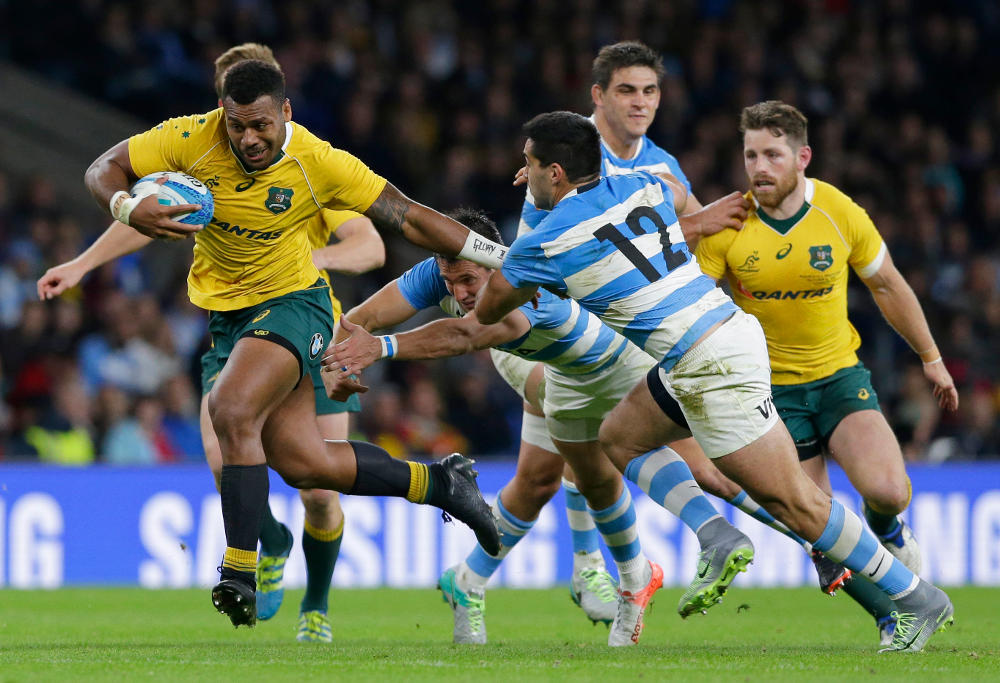At half-time in the Australia 45–Argentina 20 Test at Canberra, my guess is that every rugby writer covering the game was preparing, mentally at least, to start raising the issue of whether Michael Cheika should take the Wallabies through to the 2019 Rugby World Cup in Japan.
The first 40 minutes saw more of the same wobbly Wallabies effort from the national side. For most of the half, the Wallabies were entrenched within their own 22 and it was only silly mistakes from the Pumas and too much rushed play that prevented a blowout in the scoreline against the home side.
There was one breakout ensemble passing attack by the Wallabies that was converted into a try by a rampant Israel Folau that, in hindsight, gave a hint of what could be coming from the home side.
But this was such a brief and unexpected glimpse, somewhat like a ray of sunlight during a storm, that any hope that it might presage a revival was smashed in the next few minutes leading up to half-time when the Pumas stormed back into the Wallabies territory and forced an easy and successful penalty kick at goal to take the lead.
The Wallabies looked as if they weren’t being coached. Or if the coaching was there that the players were not responding to it.
The rot of the Wallabies’ quality that set in last June when England won the series in Australia against them 3–0 looked as if it were a permanent disease. And, if this was the case, then Michael Cheika’s position as coach had to be under severe consideration.
But a lot happened for Cheika and the Wallabies in the next 40 minutes. For the first time in a long time, they won a Test by storming back from a half-time deficit and poor play with an overwhelming display of vintage Cheika ball-in-hand rugby.
It was, to my mind, the most impressive 40 minutes of Test rugby the Wallabies have played since the final of the 2015 Rugby World Cup tournament. The point here is that this display of ensemble rugby turned what looked like an inevitable defeat into a resounding victory.
The quality of the victory, or the last 40 minutes of it, has saved Cheika’s reputation and his position as the coach of the Wallabies going into the next Rugby World Cup.
A team playing as the Wallabies did in the second half at Canberra has enough potential to be a serious contender in 2019.
This was the second time in successive Tests that the Pumas have established a half-time lead only to be over-run in the second 40 minutes.
The statistics show that in the majority of cases when a team leads at half-time, as the Pumas did against the All Blacks and the Wallabies, that team generally goes on to win the Test.
The All Blacks, for instance, win well over 90 per cent of their Tests when they are in front at half-time.

(AAP Image/SNPA, Ross Setford)
Why did the wheels fall off the Pumas’ war chariot in successive weeks? This is an important question to pose and attempt to answer when considering whether the Wallabies’ second-half revival on Saturday night was a sign of better things to come (which I believe is the case) or a gift from possibly an unfit Pumas squad.
I don’t think the Pumas are unfit. They scored a try against the Wallabies in the 77th minute of play that showed a lot of energy and some skill.
Both the All Blacks and Wallabies, admittedly in the second half of their Tests, piled on tries against the Pumas. But, in my view, this was due mainly to smart, fast ensemble play tuned to a high degree of precision by these two teams, rather than in a noticeable falling off of play by the Pumas.
In the case of the Wallabies, the smart, fast ensemble play tuned to a high degree of precision, started immediately after half-time when play ranged up and down the field for several minutes.
The Wallabies seemed to hit a sweet groove in their play from this opening sequence when there was a tremendous synchronicity between forwards and backs, with short and long passes, sweeping flank attacks and smashing, hard-shouldered charges from the big forwards.
The Pumas’ defensive lines were out-flanked and then overwhelmed in the middle of the field and in 40 minutes of play were pulled apart, conceding five tries, most of them generated by a flooding series of ensemble attacks.
It seemed to me that the Wallabies, finally, after three seasons under Michael Cheika, have come to grips with his ensemble style of play, the sort of play that took the Waratahs under his coaching to their first and only Super Rugby title.
There seemed, too, to be the same sort of method in the Wallabies onslaughts as the Waratahs in their glory days.
One of the great sights of the Test, for instance, was to see Sean McMahon thundering down the touchline to link up with a flying Nick Phipps who raced away to score one of the tries of the season.

(AP Photo/Peter Morrison)
The Wallabies kicked only 15 times the entire Test. Compare this with the All Blacks’ 37 kicks in their astonishing 57–0 demolition of the Springboks.
There is a basic difference between kicking the ball away and smart kicking, in my opinion. The All Blacks smart-kick. Perhaps the Wallabies don’t smart-kick enough, or at all.
I am averse to teams kicking away the ball, especially half-backs putting in box kicks. This ‘Jakeball’ game was exposed once again in the All Blacks’ monstering of the Springboks at Albany on Saturday night.
The Springboks employed plenty of ‘Jakeball’ kicks by the halfback. The first one was spilled by the All Blacks but the rest of the halfback bombs were defused easily enough and then thrown back at the Springboks with searing counter-attacks.
It was noticeable that the All Blacks, for their part, did not use box kicks. Beauden Barrett, rather than Aaron Smith, did the kicking and his were either very long for field position, nudges through to break up the Springboks’ defensive line, high contestable up-and-unders, or kick-passes to the wingers.
The Wallabies could look to emulate this variety of attacking kicks employed by the All Blacks.
The All Blacks rarely kick for touch. The kicking is intended to either win back the ball or force a return kick that they run back, often with devastating effect, as they showed with some of their eight tries on Saturday night.
The point here is that a lot of the All Blacks kicking is intended to disrupt the defensive patterns adopted by their opponents. This disruption is then exploited by counter-attacks that identify out weaknesses in the defensive alignments and run at them.
Even though the All Blacks kicked 37 times to the 15 of the Wallabies, they still managed to score eight tries to the six by the Wallabies, and they ran 550m to the impressive 598m by the Wallabies.
The Wallabies’ ensemble game does not have the variety that a shrewd kick-and-fetch game has.
This is a weakness. Against a well-organised defence, the continuous ball-in-hand game can become repetitive and easy enough to read and defend against.
But when the Cheika ball-in-hand method clicks, as it did in the second half of the Test against the Pumas and once in the first half with Israel Folau’s first try, it can be irresistible.

(Photo by Scott Barbour/Getty Images)
It seemed like the Pumas were flooded with a sea of gold jerseys that swamped their defensive barriers and surged inevitably like a tide towards their try line throughout the entire second half.
When the surge of gold jerseys is on it is one of the most thrilling sights in modern rugby. Thrilling and seemingly irresistible. This is what we saw in the second half of the Test at Canberra and it was impressive.
It seems to me, too, that Cheika has finally got his starting pack right.
I have never been a great admirer of Rob Simmons’ play in the past. He has, throughout his career, not made enough of his physical gifts – his height, skills and pace.
But for once he was assertive in every aspect of his play and this aggression lifted the Wallabies pack.
The back row worked well, too, with Ned Hanigan playing his best Test in the tight-loose which allowed Sean McMahon to occasionally go wide and make the blistering break that led to the try by Nick Phipps.
In the backs, though, there is some room for adjustments in tactics and selection.
The best way to use Kurtley Beale, for instance, is to play him at fullback where he can be a first receiver on occasions and can make incursions into attacks when the ball comes his way.
His positional play at fullback, too, is far superior to that of Israel Folau.
The obvious spot for Folau is on the wing, a position that would allow him to roam wherever he wants to on the field in much the same manner as David Campese, of blessed memory.
These changes would allow a centre combination of Samu Kerevi and Tevita Kuridrani.

(AP Photo/Alastair Grant)
A back line with these changes will challenge any defence on the planet, including the All Blacks.
The big question now for Cheika, aside from perhaps tinkering with the starting side, is how he prepares the Wallabies for their next Test in two weeks’ time at Bloemfontein.
The All Blacks have set the template for how to smash the Springboks. It starts by destroying their line-out. Then it continues by running the big pack around by sending wave after wave of counter-attacks at them.
The Wallabies have set the template for this sort of onslaught with their second-half play against the Pumas.
But will their set pieces, lineouts and scrums, hold against the Springboks?
A rare victory in South Africa for the Wallabies in two weeks’ time will confirm that the team is at last coming out of its dark tunnel.

































































































